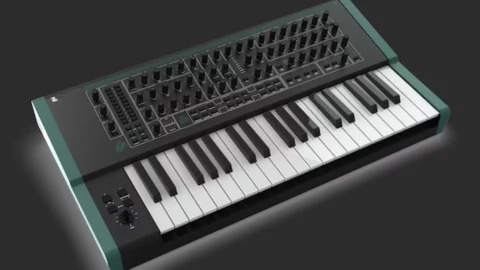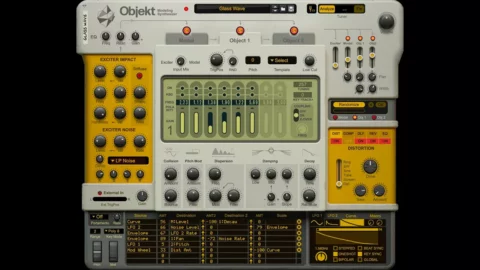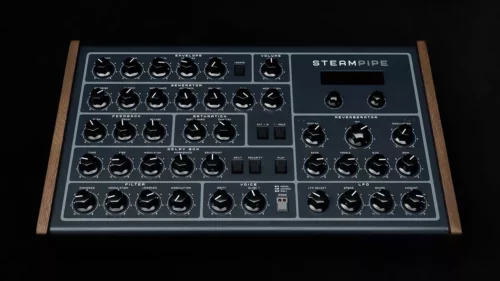PWM Mantis Duophonic Synthesizer a Spiritual Successor to EDW Wasp

PWM Mantis is a Wasp-style synth with an OSCar-inspired filter
The Mantis is a collaboration between the late Chris Hugget (Gnat, Wasp, Oscar) and Paul Whittington of PWM, and turned out to be the legendary designer’s final synth.
Here, Whittington tells the story of the synth’s origin:
PWM’s Paul Whittington calls Mantis a “unique-sounding synth” and a “beautiful collaboration”, confirming that it’s being released with the blessing of Huggett’s family. “We are thrilled to bring you our new synth that we are sure will be loved as much as he was!” he says.
Mantis is duophonic and features mathematically generated oscillators and an analogue signal path, both of which are based on Huggett’s designs. In fact, Mantis is said to offer a contemporary architecture based on Hugget’s classic Wasp synth, plus a filter that takes its lead from his OSCar instrument. There are two oscillators plus a sub-oscillator per voice, with the oscillator drift feature creating random pitch variations between the oscillators.
Each signal path has its own multimode analogue filter, and there are also two LFOs and two independent envelopes. You have a choice of six ‘control’ modulation parameters, and six ‘source’ effectors.
Other features include a digital effects section with reverb and chorus, an arpeggiator and a full-size 37-note keyboard with velocity-sensitive keys.
Features:
- 200 Patches
- All patches in RAM so can be overwritten
- Bank A: 100 Factory presets
- Bank B: 100 User presets (all set to initial patch)
- Compare function
- Initialize patch function
- Duophonic with 2 analog signal paths
- Mathematically generated oscillators designed by Chris Huggett
- Analogue signal path designed by Chris Huggett
- 2 Oscillators plus sub-oscillator per voice
- Sine / Triangle / Saw / Pulse plus additional wave types
- Shape control and shape modulation input
- Will create pulse width modulation on the pulse waveform with perfect square
- at the center
- Pitch modulation control
- Octave selects per oscillator
- OSC 1 SUB follows oscillator 1 parameters
- Oscillator Drift
- Creates random pitch variations between oscillators
- ?Multi-mode state variable VCA filters with overdrive
- 2 Analogue filters – 1 per signal path
- Low Pass / Band Pass / High Pass in 12dB and 24dB configurations
- Additional WBAND (series) and WSTOP (parallel) types
- Filter Cutoff
- Filter Cutoff Modulation
- Filter Resonance
- Filter Width
- Filter Width Modulation
- Filter Keytrack
- LFO (Low Frequency Oscillator)
- 2 LFOs
- 4 waveshapes per oscillator
- Fade In / Fade Out parameter
- SYNCable
- Rate control
- Envelopes
- 2 Independent envelopes
- ENV 1 normalised to amplitude
- ADSR
* + Sustain Fall parameter for shaping during key-down
* + Repeat which can be used to create looping envelopes
* Velocity positive and negative control
- Ring modulation
- Mixer
- First mix: OSC1 and OSC2
- Second mix: OSCillators and noise
- Third mix: OSCillators + noise and Ring modulator
- VCA (Voltage Controlled Amplifier)
- All amplification is done in the analogue domain in multi-stage VCAs
- Modulation Routes
- Control – 6 choices of modulation parameters
- Source – 6 choices of effectors from envelopes and LFOs
- Scale – choices of controls used to scale the effect of the modulation
- Glide
- Glide amount
- Auto-glide mode
- Indicator LEDs
- Two LEDs for Voice
- LED for Keyboard activity
- Master tune
- Master volume
- Triggering
- ENV 1 Legato
- ENV 2 Legato
- LFO Keytrig
- LFO Keytrig
- CONNECTIONS
- Master power switch
- DC 9V input
- USBC
- MIDI IN / OUT / THRU
- Sustain pedal input (switch)
- Pedal input (continuous)
- Stereo 1/4” line Outs: L/Mono and R
- Stereo 1/4” headphone out
- ?Multi-function Joystick control
- Left / right for pitch bend
- Performable vibrato
- Latching hold mode
- Arpeggiator
- 6 arpeggiator types – Up, Down, Up/Down 1, Up/Down 2, Played & Random
- Sync rates control from 2nds to 32nds
- Tap tempo button
- Swing including positive and negative swing
- Auto clock sync – Detects MIDI or USB-MIDI clock and synchronises the arpeggiator
- automatically
- Latch via joystick HOLD
- 6 Octave range
- Dedicated tempo control
- Duophonic mode control
- Duo mode
- Duo mode with simple filter
- Pan control for duophonic voicing
- Digital Effects
- Reverb time
- Reverb level
- Reverb High Pass Filter
- Reverb Low Pass Filter
- Chorus level
- Chorus type
- Keyboard Control
- 37 Full-size semi-weighted velocity-sensitive keys
- Channel aftertouch
- Octave shift
Mantis is scheduled to ship in the summer priced at $1,499/£1,349/€1,599. Find out more on the PWM website.



